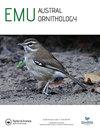边缘植被在支持鸟类进入干旱区水坑中的作用
IF 1.1
4区 生物学
Q3 ORNITHOLOGY
引用次数: 2
摘要
在干旱地区,特别是在炎热和干燥的时期,当对水的代谢需求增加时,获得饮用水对许多鸟类来说是必不可少的。在需水量增加的14个月期间,研究了边缘植被对干旱区鸟类群落取水的促进作用。在澳大利亚中部的麦克唐奈山脉生物区,鸟类在两个夏天和一个冬天使用相机陷阱记录了它们对六个长期水坑的访问。物种根据其大小和偏好的觅食基质被划分为功能类。采用广义线性混合模型检验边缘植被变量与每个功能类的独立捕获事件之间的关系。边缘植被是中小型树冠觅食动物进入水坑的关键。在最近的乔木或灌木覆盖大于10 m的地区,它们的活动几乎为零。随着天气条件变得越来越干燥和炎热,这种关系的强度是一致的。然而,中小型树冠觅食者的活动与最近的树木或灌木的树冠覆盖百分比负相关,可能是因为稀疏的植被覆盖提供了更大的能见度,当接近水边时。相比之下,地面觅食者和猛禽在水坑的活动与周围的植被无关,这些群体经常从开阔的区域获取水。在未来变暖的情况下,如果小型和中型树冠觅食动物被迫在远离附近边缘植被的地方取水,它们可能很容易受到捕食者的攻击。本文章由计算机程序翻译,如有差异,请以英文原文为准。
The role of fringing vegetation in supporting avian access to arid zone waterholes
ABSTRACT Access to drinking water is essential for many avian species in arid landscapes, especially in hot and dry periods when metabolic requirements for water increase. The role of fringing vegetation in facilitating surface water access by arid zone bird communities was investigated over a 14-month period during which water demand increased. Bird visitation to six long-lasting waterholes in the MacDonnell Ranges Bioregion in central Australia was recorded over two summers and one winter using camera traps. Species were assigned to functional classes based on their size and preferred foraging substrate. Generalised linear mixed models were used to test relationships between fringing vegetation variables and the independent trapping events for each functional class. Fringing vegetation was critical for small and intermediate-sized canopy foragers to access waterhole sites. Their activity declined to almost zero in areas where the nearest tree or shrub cover was greater than 10 m. The strength of this relationship was consistent as weather conditions became drier and hotter. However, activity of small and intermediate-sized canopy foragers was negatively related to the percent canopy cover of the nearest tree or shrub, potentially because sparse vegetative cover offers greater visibility when approaching the water’s edge. In contrast, ground forager and raptor activity at waterhole sites was unrelated to surrounding vegetation, and these groups frequently accessed water from open areas. Under future warming scenarios, small and intermediate canopy foragers may be vulnerable to predation if they are forced to access water at sites away from nearby fringing vegetation.
求助全文
通过发布文献求助,成功后即可免费获取论文全文。
去求助
来源期刊

Emu-Austral Ornithology
生物-鸟类学
CiteScore
2.00
自引率
7.70%
发文量
33
审稿时长
>12 weeks
期刊介绍:
Emu – Austral Ornithology is the premier journal for ornithological research and reviews related to the Southern Hemisphere and adjacent tropics. The journal has a long and proud tradition of publishing articles on many aspects of the biology of birds, particularly their conservation and management.
 求助内容:
求助内容: 应助结果提醒方式:
应助结果提醒方式:


